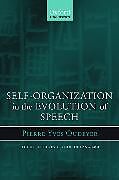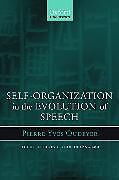Self-Organization in the Evolution of Speech
Einband:
Kartonierter Einband
EAN:
9780199289158
Untertitel:
Englisch
Autor:
Pierre-Yves Oudeyer
Herausgeber:
OUP Oxford
Anzahl Seiten:
192
Erscheinungsdatum:
01.05.2006
ISBN:
0199289158
Informationen zum Autor Pierre-Oudeyer is a researcher at Sony Computer Science Laboratory, Paris. He studies the origins and evolution of language, and is a specialist of computer modelling, including robotic systems, artificial intelligence, and developmental systems. His work on the origins of speech was awarded the French Prix Le Monde de la recherche universitaire, 2004 and the Prix ASTI in 2005. James R. Hurford is Professor of Linguistics at the University of Edinburgh. His books include Semantics (with B. Heasley, 1983), Grammar (1994), and as co-editor Approaches to the Evolution of Language (1998), all published by CUP. Klappentext Oudeyer combines insights from neuroscience! evolutionary biology! and linguistics to explore questions about the origins of speech. He puts forward the startling proposal that speech can be spontaneously generated by the coupling of evolutionarily simple neural structures connecting perception and production. He tests this hypothesis through a computational system and shows that the linking of auditory and vocal motor neural nets produces syntactic rules that exhibit the fundamental properties of modern human speech systems. This fascinating account will interest all those interested in the evolution of speech. Zusammenfassung Speech is the principal supporting medium of language. In this book Pierre-Yves Oudeyer considers how spoken language first emerged. He presents an original and integrated view of the interactions between self-organization and natural selection, reformulates questions about the origins of speech, and puts forward what at first sight appears to be a startling proposal - that speech can be spontaneously generated by the coupling of evolutionarily simple neural structures connecting perception and production. He explores this hypothesis by constructing a computational system to model the effects of linking auditory and vocal motor neural nets. He shows that a population of agents which used holistic and unarticulated vocalizations at the outset are inexorably led to a state in which their vocalizations have become discrete, combinatorial, and categorized in the same way by all group members. Furthermore, the simple syntactic rules that have emerged to regulate the combinations of sounds exhibit the fundamental properties of modern human speech systems.This original and fascinating account will interest all those interested in the evolution of speech. Inhaltsverzeichnis 1: The Self-Organization Revolution in Science 2: The Human Speech Code 3: Self-Organization and Evolution 4: Existing Theories 5: Artificial Systems as Research Tools for Natural Sciences 6: The Artificial System 7: Learning Perceptuo-Motor Correspondences 8: Strong Combinatoriality and Phonotactics 9: New Scenarios 10: Constructing for Understanding References Index ...
Klappentext
Oudeyer combines insights from neuroscience, evolutionary biology, and linguistics to explore questions about the origins of speech. He puts forward the startling proposal that speech can be spontaneously generated by the coupling of evolutionarily simple neural structures connecting perception and production. He tests this hypothesis through a computational system and shows that the linking of auditory and vocal motor neural nets produces syntactic rules that exhibit the fundamental properties of modern human speech systems. This fascinating account will interest all those interested in the evolution of speech.
Zusammenfassung
Speech is the principal supporting medium of language. In this book Pierre-Yves Oudeyer considers how spoken language first emerged. He presents an original and integrated view of the interactions between self-organization and natural selection, reformulates questions about the origins of speech, and puts forward what at first sight appears to be a startling proposal - that speech can be spontaneously generated by the coupling of evolutionarily simple neural structures connecting perception and production. He explores this hypothesis by constructing a computational system to model the effects of linking auditory and vocal motor neural nets. He shows that a population of agents which used holistic and unarticulated vocalizations at the outset are inexorably led to a state in which their vocalizations have become discrete, combinatorial, and categorized in the same way by all group members. Furthermore, the simple syntactic rules that have emerged to regulate the combinations of sounds exhibit the fundamental properties of modern human speech systems. This original and fascinating account will interest all those interested in the evolution of speech.
Inhalt
1: The Self-Organization Revolution in Science
2: The Human Speech Code
3: Self-Organization and Evolution
4: Existing Theories
5: Artificial Systems as Research Tools for Natural Sciences
6: The Artificial System
7: Learning Perceptuo-Motor Correspondences
8: Strong Combinatoriality and Phonotactics
9: New Scenarios
10: Constructing for Understanding
References
Index

Leider konnten wir für diesen Artikel keine Preise ermitteln ...
billigbuch.ch sucht jetzt für Sie die besten Angebote ...
Die aktuellen Verkaufspreise von 6 Onlineshops werden in Realtime abgefragt.
Sie können das gewünschte Produkt anschliessend direkt beim Anbieter Ihrer Wahl bestellen.
Loading...
Die aktuellen Verkaufspreise von 6 Onlineshops werden in Realtime abgefragt.
Sie können das gewünschte Produkt anschliessend direkt beim Anbieter Ihrer Wahl bestellen.
| # | Onlineshop | Preis CHF | Versand CHF | Total CHF | ||
|---|---|---|---|---|---|---|
| 1 | Seller | 0.00 | 0.00 | 0.00 |
